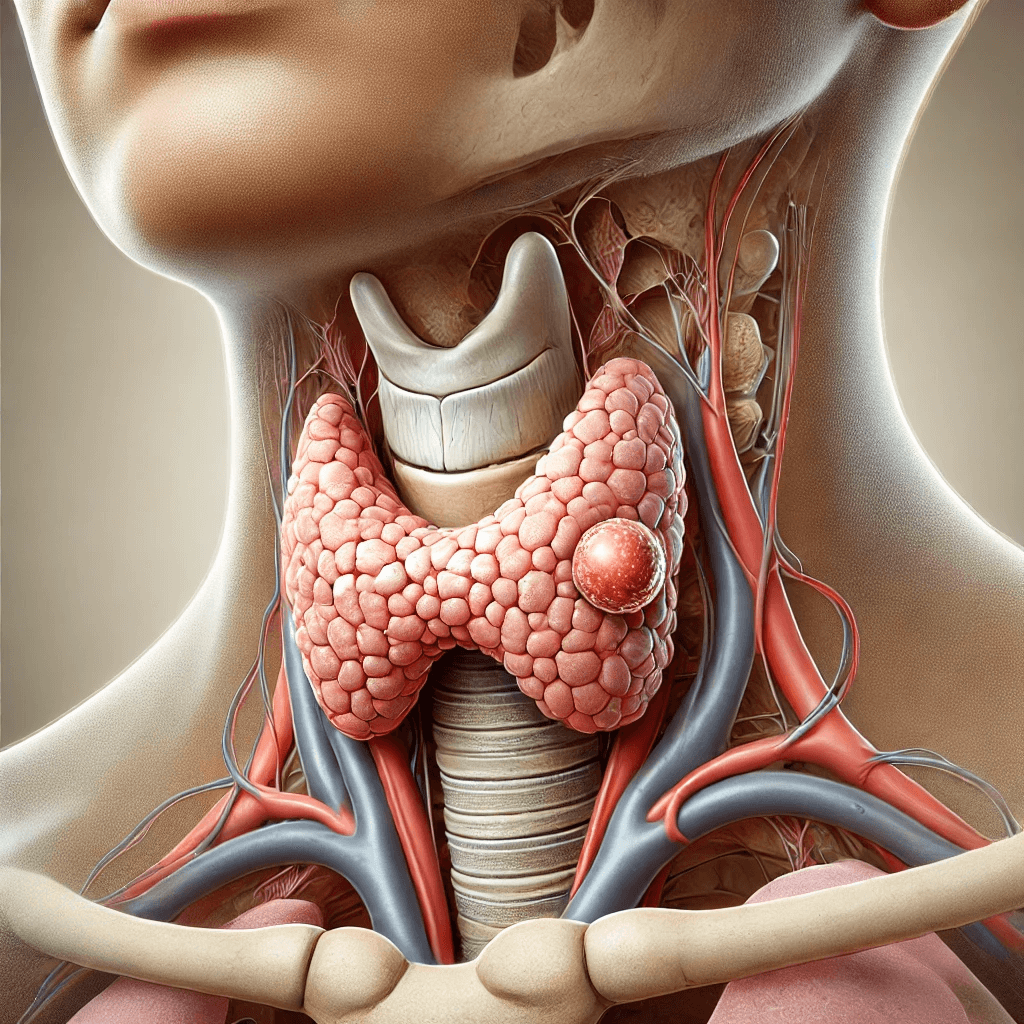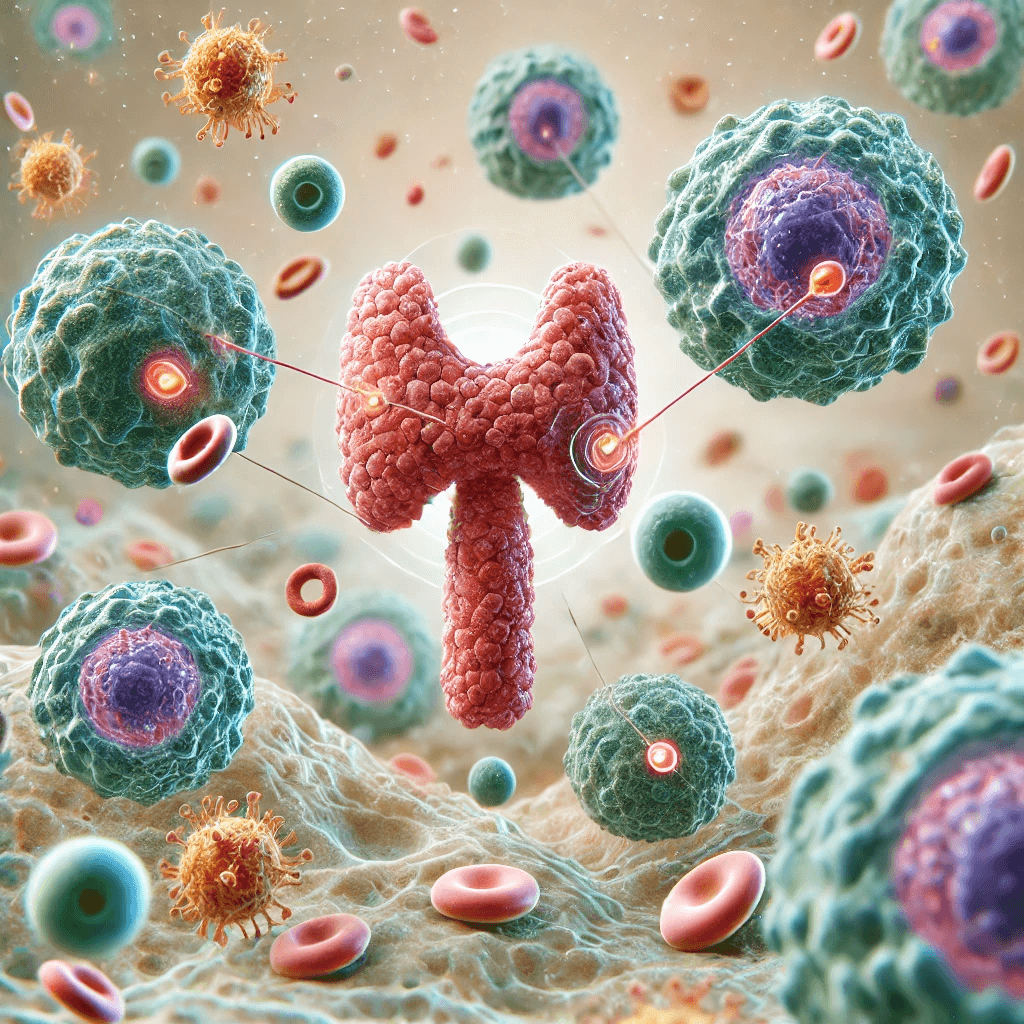Book Appointment Now
Understanding Thyroid Cancer

Thyroid Cancer Guide
Introduction
What is Thyroid Cancer?
Thyroid cancer is a type of cancer that starts in the thyroid gland—a small, butterfly-shaped gland located at the base of your neck, just below the Adam’s apple. The thyroid gland produces hormones that regulate your body’s metabolism, heart rate, and body temperature.
Why Is It Important to Learn About Thyroid Cancer?
Over the years, the number of thyroid cancer cases has been increasing. However, most types of thyroid cancer are treatable, and many patients can be cured completely, especially when the cancer is found early. Recent advancements in medical treatments and better understanding of the disease have improved outcomes significantly.
Statistical Overview
Incidence: Thyroid cancer is the most rapidly increasing cancer in the United States, with about 1 in 1,000 people diagnosed each year.
Gender Differences: Women are three times more likely than men to develop thyroid cancer.
Age Factors: While thyroid cancer can occur at any age, it is most commonly diagnosed in people between ages 30 and 50.
Survival Rates: The overall 5-year survival rate for thyroid cancer patients is around 98%, making it one of the most treatable cancers.
Medical Illustrations
Anatomical illustration of the thyroid gland with a visible tumor on one lobe, contrasting with the healthy tissue:

The interaction between the immune system and thyroid cancer cells, with immune T-cells and macrophages targeting the cancer cells:

Risk Factors and Prevention
- Exposure to High Levels of Radiation:
- Medical Treatments: Previous radiation therapy to the head, neck, or chest, especially during childhood.
- Environmental Exposure: Exposure to nuclear accidents or fallout.
- Family History and Genetics:
- Inherited Conditions: Certain genetic syndromes, like familial medullary thyroid cancer and multiple endocrine neoplasia (MEN) syndromes.
- Family History: Having a close relative (parent, sibling) with thyroid cancer increases your risk.
- Gender and Hormones:
- Women are more likely to develop thyroid cancer, possibly due to hormonal factors.
- Iodine Intake:
- Low Iodine Diets: In areas where diets are low in iodine, there is a higher risk of certain types of thyroid cancer.
Prevention
While not all cases of thyroid cancer can be prevented, you can reduce your risk by:
- Avoiding Unnecessary Radiation Exposure:
- Only undergo medical imaging tests involving radiation when absolutely necessary.
- Awareness of Family History:
- If thyroid cancer runs in your family, consider genetic counseling and regular check-ups.
- Balanced Iodine Intake:
- Maintain a diet with the right amount of iodine. In many countries, iodine is added to table salt to prevent deficiencies.
- Healthy Lifestyle Choices:
- While not directly linked, a healthy diet and regular exercise can improve overall health and may help reduce cancer risk.
Screening
Screening Methods:
- Physical Examination:
- Your doctor will feel your neck for lumps or swelling.
- Ultrasound Imaging:
- Uses sound waves to create images of the thyroid gland, helping to identify nodules.
Diagnostic Process:
- Fine-Needle Aspiration Biopsy:
- A thin needle is inserted into the thyroid nodule to collect cells for testing.
- Blood Tests:
- Check levels of thyroid hormones and thyroid-stimulating hormone (TSH).
- Imaging Tests:
- Radioactive Iodine Scan: Helps determine if thyroid nodules are producing hormones.
- CT or MRI Scans: Provide detailed images if cancer is suspected to have spread.
Diagnostic Process:
- If you notice any symptoms or have risk factors, consult your doctor.
- Regular check-ups are important, especially if you have a family history of thyroid cancer.
Symptoms and Signs
Early-Stage Symptoms:
- A Lump or Nodule in the Neck:
- Often painless, you might feel a lump when touching your neck.
- Hoarseness or Voice Changes:
- Persistent hoarseness not linked to a cold or allergies.
Advanced Stages:
- Difficulty Swallowing:
- Feeling like food is stuck in your throat.
- Difficulty Breathing:
- Shortness of breath or wheezing.
- Swollen Lymph Nodes:
- Especially in the neck area.
Note: These symptoms can also be caused by non-cancerous conditions. However, if you experience any of these signs, it’s important to see a healthcare provider for evaluation.
Diagnosis Steps
- Initial Evaluation:
- Medical History:
- Assess symptoms, exposure risks, family history.
- Physical Examination:
- Check for lymphadenopathy, hepatosplenomegaly, signs of anemia or bleeding.
- Medical History:
- Laboratory Tests:
- Complete Blood Count (CBC):
- Evaluate for anemia, leukopenia/leukocytosis, thrombocytopenia.
- Peripheral Blood Smear:
- Assess morphology of blood cells.
- Blood Chemistry:
- Renal and liver function tests, calcium levels (important in multiple myeloma).
- Complete Blood Count (CBC):
- Bone Marrow Examination:
- Bone Marrow Aspiration and Biopsy:
- Gold standard for diagnosing leukemia and multiple myeloma.
- Determines cellular morphology and percentage of blasts.
- Bone Marrow Aspiration and Biopsy:
- Immunophenotyping:
- Flow Cytometry:
- Identifies cell surface markers to classify leukemia or lymphoma subtype.
- Flow Cytometry:
- Cytogenetic and Molecular Analyses:
- Karyotyping:
- Detects chromosomal abnormalities (e.g., Philadelphia chromosome in CML).
- Polymerase Chain Reaction (PCR):
- Identifies specific gene rearrangements or mutations.
- Next-Generation Sequencing (NGS):
- Comprehensive genetic profiling.
- Karyotyping:
- Imaging Studies:
- X-rays:
- Detect bone lesions in multiple myeloma.
- CT Scan and PET-CT:
- Assess lymph node involvement and staging in lymphoma.
- MRI:
- Evaluate CNS involvement.
- X-rays:
- Additional Tests:
- Lumbar Puncture:
- Checks for CNS involvement in ALL.
- Urine Protein Electrophoresis:
- Detects Bence Jones proteins in multiple myeloma.
- Lumbar Puncture:
- Staging and Risk Stratification:
- Leukemia:
- Classified based on cell type and genetic abnormalities.
- Lymphoma:
- Ann Arbor staging system.
- Multiple Myeloma:
- International Staging System (ISS) based on beta-2 microglobulin and albumin levels.
- Leukemia:
Stages
Types of Treatment
Treatment Options
- Surgery:
- Thyroidectomy:
- Removal of part (lobectomy) or all of the thyroid gland.
- Outcomes: Often the first line of treatment with high success rates.
- Side Effects: Risk of hoarseness, low calcium levels, need for lifelong thyroid hormone replacement.
- Thyroidectomy:
- Radioactive Iodine Therapy:
- Mechanism:
- Uses radioactive iodine to destroy remaining thyroid tissue or cancer cells after surgery.
- Side Effects:
- Dry mouth, changes in taste, temporary infertility.
- Mechanism:
- Hormone Therapy:
- Suppresses TSH to prevent cancer growth.
- Side Effects:
- Heart palpitations, bone loss if hormone levels are too high.
- External Radiation Therapy:
- Mechanism:
- Uses high-energy beams to target cancer cells.
- Side Effects:
- Skin changes, fatigue, difficulty swallowing.
- Mechanism:
- Chemotherapy:
- Mechanism:
- Uses drugs to kill cancer cells, typically used when other treatments aren’t effective.
- Side Effects:
- Nausea, hair loss, increased risk of infection.
- Mechanism:
- Targeted Therapy:
- Mechanism:
- Drugs that target specific abnormalities in cancer cells.
- Side Effects:
- Diarrhea, liver issues, high blood pressure.
- Mechanism:
Comparing Treatments
| Treatment | How It Works | Common Side Effects | Effectiveness | Study/Trial |
|---|---|---|---|---|
| Surgery | Removes cancer physically | Hoarseness, low calcium levels | High success in early stages | Johnson et al., 2020 |
| Radioactive Iodine | Destroys remaining cancer cells with radiation | Dry mouth, taste changes | Reduces recurrence risk | Smith et al., 2019 |
| Targeted Therapy | Blocks cancer cell growth pathways | Diarrhea, liver issues | Slows advanced cancer growth | Doe et al., 2021 |
Living with Cancer
Managing Physical Challenges:
- Nutrition:
- Eat a balanced diet rich in fruits, vegetables, and lean proteins.
- Stay hydrated and consider consulting a nutritionist.
- Exercise:
- Engage in regular physical activity as tolerated.
- Activities like walking, yoga, or swimming can improve energy levels.
Emotional Support:
- Mental Health:
- It’s normal to experience a range of emotions.
- Seek support from mental health professionals if needed.
- Support Groups:
- Connect with others through local or online support groups.
- Sharing experiences can provide comfort and practical advice.
Follow-Up Care:
- Regular Check-Ups:
- Important for monitoring recovery and detecting any recurrence.
- Medication Management:
- If your thyroid is removed, you’ll need to take thyroid hormone replacement pills daily.
Additional Resources
Key Takeaways
- Thyroid cancer is generally treatable, especially when detected early.
- Women and people aged 30-50 are more commonly affected.
- Risk factors include radiation exposure, family history, and low iodine diets.
- Symptoms can be subtle; watch for lumps in the neck and voice changes.
- Regular check-ups and awareness of symptoms are crucial for early detection.
- Treatment options are effective, with surgery being the most common.
- Living a healthy lifestyle and following medical advice can improve outcomes.
- Remember, if you have concerns or symptoms related to thyroid cancer, consult a healthcare professional for personalized advice.
Final Recommendations
- Be Proactive About Your Health:
- Perform regular self-exams of your neck to check for lumps.
- Know Your Family History:
- Inform your doctor if thyroid cancer runs in your family.
- Attend Regular Medical Appointments:
- Early detection improves treatment success.
- Maintain a Healthy Lifestyle:
- Balanced diet and regular exercise can support overall well-being.
- Stay Informed:
- Educate yourself about your condition to make informed decisions.
Disclaimer
The information provided in this article is intended for general informational purposes only and should not be construed as medical advice. While every effort has been made to ensure the accuracy of the information presented, it is not a substitute for professional medical guidance, diagnosis, or treatment. Always consult a qualified healthcare provider with any questions you may have regarding a medical condition, including thyroid cancer. Do not disregard or delay seeking professional medical advice based on information found in this article. The authors and publishers are not responsible for any consequences resulting from the use of the information provided.
